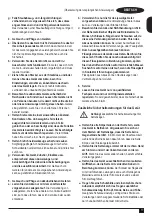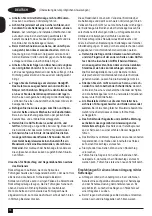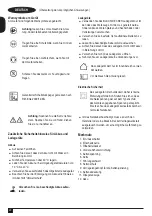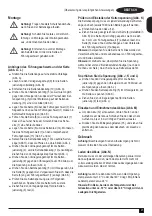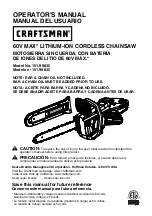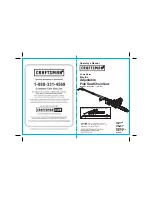
10
ENGLISH
(Original instructions)
Features
1. On/off switch
2. Lock-off button
3. Oil cap
4. Front guard
5. Chain tension adjustment ring
6. Chain
7. Guide bar
8. Chain sheath
9. Chain adjust locking knob
10. Chain cover assembly
11. Oil level indicator
12. Battery
Assembly
@
Warning!
Always wear protective gloves when
working on your chainsaw.
@
Warning!
Before performing any assembly
or maintenance on power tools, switch off and
remove the battery.
@
Warning!
Remove the cable tie that attaches
the chain to the chainbar before assembly.
Fitting the guide bar and chain. (fig. A - L)
u
Place the chainsaw onto a stable surface (fig. A).
u
Fully loosen the chain adjust locking knob (9) (fig. B).
u
Remove the chain cover assembly (10) (fig. C).
u
Turn the tension adjust ring (5) anti-clockwise as far as it
will go so the arrow on the tension adjust ring (5) lines up
with the marker on the chain cover assembly (13) (fig. D)
u
Place the chain (6) over the guide bar (7) making sure that
the saw chain cutters on the upper part of the guide bar
(7) face towards the front (fig. E).
u
Guide the chain (6) around the guide bar (7) and pull it to
create a loop to one side at the rear end of the guide bar
(7).
u
Guide the chain (6) around the drive sprocket (14). Place
the guide bar (7) onto the bar location studs (15) (fig. F &
G).
u
Place the chain cover assembly (10) onto the chainsaw
(fig. H) making sure the arrows are aligned (fig. I).
u
Turn the chain adjust locking knob (9) clockwise to attach
the chain cover assembly (10) and lightly tighten (fig. I).
u
Turn the chain adjust locking knob (9) 180 degrees anti-
clockwise to release the tension (fig J).
u
Turn the chain tension adjust ring (5) clockwise until the
chain (6) is tight. Make sure that the chain (6) is snug
around the guide bar (7) (fig. K).
u
Check the tension as described below. Do not overtighten.
u
Tighten the chain adjust locking knob (9) (L).
Checking and adjusting the chain tension (fig. K)
Before use and after every 10 minutes of use, you must check
the chain tension.
u
Remove the battery (12).
u
Lightly pull on the chain (6) as shown (inset fig. K). The
tension is correct when the chain (6) snaps back after
being pulled 3 mm away from the guide bar (7). There
should be no "sag" between the guide bar (7) and the
chain (6) on the underside.
Note:
Do not over-tension the chain as this will lead to
excessive wear and will reduce the life of the guide bar and
the chain.
Note:
When the chain is new, check the tension frequently
(after disconnecting from the mains) during the first 2 hours of
use because a new chain stretches slightly.
To increase the tension (fig. J, K & L)
u
Turn the chain adjust locking knob (9) 180 degrees anti-
clockwise to release the tension. (fig. J)
u
Tension the chain using the chain tension adjusting ring
(5), turn clockwise to tighten (fig K).
u
Tighten the chain adjust locking knob (9) (fig. L).
Fitting and removing the battery (fig. M)
u
To fit the battery (12), line it up with the receptacle on the
tool. Slide the battery into the receptacle and push until
the battery snaps into place.
u
To remove the battery, push the release buttons (16) while
at the same time pulling the battery out of the receptacle.
Use
Warning!
Let the tool work at its own pace. Do not overload.
Charging the battery (fig. N)
The battery needs to be charged before first use and whenev
-
er it fails to produce sufficient power on jobs that were easily
done before. The battery may become warm while charging;
this is normal and does not indicate a problem.
Warning!
Do not charge the battery at ambient temperatures
below 10 °C or above 40 °C. Recommended charging tem
-
perature: approx. 24 °C.
Note: The charger will not charge a battery if the cell
temperature is below approximately 10 °C or above 40 °C.
The battery should be left in the charger and the charger
will begin to charge automatically when the cell tempera-
ture warms up or cools down.
Summary of Contents for GKC1825L20
Page 1: ...www blackanddecker eu GKC1825L20...
Page 2: ...2 A B C D E...
Page 3: ...3 G H I J K F...
Page 4: ...4 L M N P Q O...
Page 5: ...5 R S T V U...
Page 123: ...123 BLACK DECKERTM 1 2 RCD RCD 3 OFF...
Page 124: ...124 4 5 6...
Page 125: ...125 u u u u u u u u u u u u...
Page 126: ...126 u u u u u u u u u u u u u u u u u u u u 85 dB A u u u...
Page 131: ...131 u u u u u u u S T U 20 S u u u u u U u V...
Page 132: ...132 2 21 E 30 u u 7 6 u u 21 Black Decker...
Page 135: ......

















